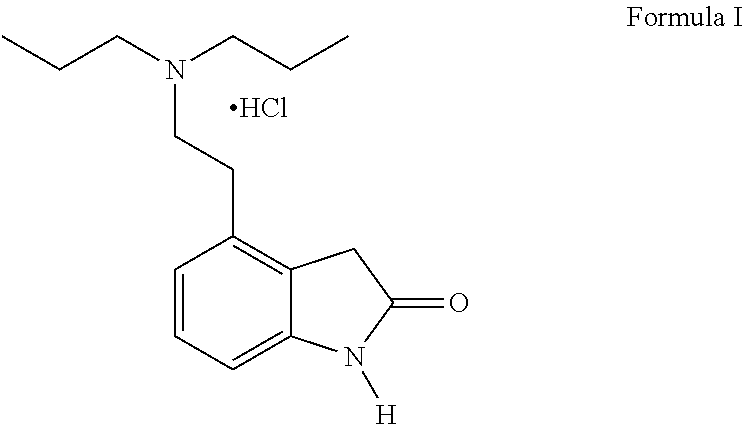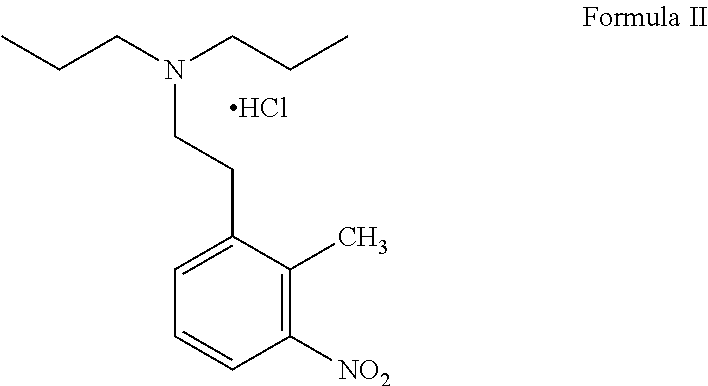Process for the preparation of ropinirole and salts thereof
a technology of ropinirole and salt, which is applied in the field of process for the preparation of ropinirole and pharmaceutical acceptable salts, can solve the problems of non-satisfactory product yield of ropinirole hydrochloride, process is not suitable for large-scale production, and compound often contains significant amounts of impurities, so as to achieve cost-effective effect, sacrificing yield and quality of produ
- Summary
- Abstract
- Description
- Claims
- Application Information
AI Technical Summary
Benefits of technology
Problems solved by technology
Method used
Image
Examples
example 1
Preparation of 6-[2-(di-n-propylamino) ethyl]-2-nitrophenyl acetic acid hydrochloride
[0054]Under nitrogen atmosphere, 38 g of sodium metal (cut into pieces) is suspended in 350 ml of anhydrous tetrahydrofuran (THF) and 350 ml of absolute ethanol is carefully added over a period of 120-180 minutes, while maintaining the temperature below 15° C. and it is stirred for additional 60-90 min. The solution is stirred at about 25-30° C. until all the sodium metal has been dissolved. This will generally take 20-24 hrs. The solution is cooled down to temperature below 15° C. and 225 ml of diethyl oxalate is charged, over a period of 40-70 min, while maintaining the temperature below 15° C. Subsequently, a solution of 100 g of N-[2-(2-methyl-3-nitrophenyl)ethyl]-N-propylpropan-1-amine hydrochloride in 50 ml anhydrous THF and 100 ml absolute ethanol (preheated till dissolved and cooled at 30-35 ° C.) is charged at temperature of about 25-30° C. and the reaction mass is stirred for approximately...
example 2
Preparation of Crude 4-[2-(di-n-propylamino) ethyl]-1, 3-dihydro-1H-indol-2-one hydrochloride
[0059]
[0060]100 g of 6-[2-(di-n-propylamino) ethyl]-2-nitrophenyl acetic acid hydrochloride is dissolved in 1500 ml methanol and the solution is charged to a high pressure reactor. A suspension of 20 g of Pd / C 5% (50% wet) in 50 ml methanol is added (wash the flask which contained the suspension with 50 ml methanol) and the reactor is sealed. Hydrogen gas is charged at temperature of about 25-35° C. until the pressure reaches 2.8-4.4 kg / cm2 and the mixture is stirred for about 2-4 hrs. The catalyst is filtered and washed with 200 ml methanol. The filtrate is evaporated to dryness (apply vacuum at the end of distillation).
[0061]The residue is charged to 1000 ml D.M. water and 2000 ml toluene. About ˜18 ml aq. NaOH (50% w / v) is added to adjust the pH value of the aqueous layer to pH 9.0-9.2. The mixture is stirred for 10-20 min and the layers are separated. The aqueous layer is extracted with ...
example 3
Purification of 4-[2-(Di-n-propylamino) ethyl]-1, 3-dihydro-1H-indo1-2-one hydrochloride (Ropinirole Hydrochloride)
[0064]100 g of crude 4-[2-(di-n-propylamino) ethyl]-1, 3-dihydro-1H-indol-2-one hydrochloride is added into 375 ml methanol. The mixture is degassed at temperature of 25-30° C. and heated to 64-66° C. with stirring until dissolution. Then, the mixture is cooled to temperature of 60-63° C. and filtered under inert atmosphere. The filtrate is re-heated to 60-63° C. and 200 ml acetone is added over a period of 5-15 min, maintaining the solution temperature at 55-60° C. The mass is cooled to 0-5° C. over a period of 60-120 min and stirring is continued for 60-90 minutes.
[0065]The suspension is filtered through Buchner funnel and slurry-washed with 200 ml Acetone. The wet cake is dried in vacuum oven at 50-55° C. till LOD≦0.5%. The yield obtained is 80-90 g.
[0066]The present invention describes a large-scale manufacture process for the preparation of Ropinirole hydrochloride...
PUM
| Property | Measurement | Unit |
|---|---|---|
| temperature | aaaaa | aaaaa |
| pH | aaaaa | aaaaa |
| pH | aaaaa | aaaaa |
Abstract
Description
Claims
Application Information
 Login to View More
Login to View More - R&D
- Intellectual Property
- Life Sciences
- Materials
- Tech Scout
- Unparalleled Data Quality
- Higher Quality Content
- 60% Fewer Hallucinations
Browse by: Latest US Patents, China's latest patents, Technical Efficacy Thesaurus, Application Domain, Technology Topic, Popular Technical Reports.
© 2025 PatSnap. All rights reserved.Legal|Privacy policy|Modern Slavery Act Transparency Statement|Sitemap|About US| Contact US: help@patsnap.com



